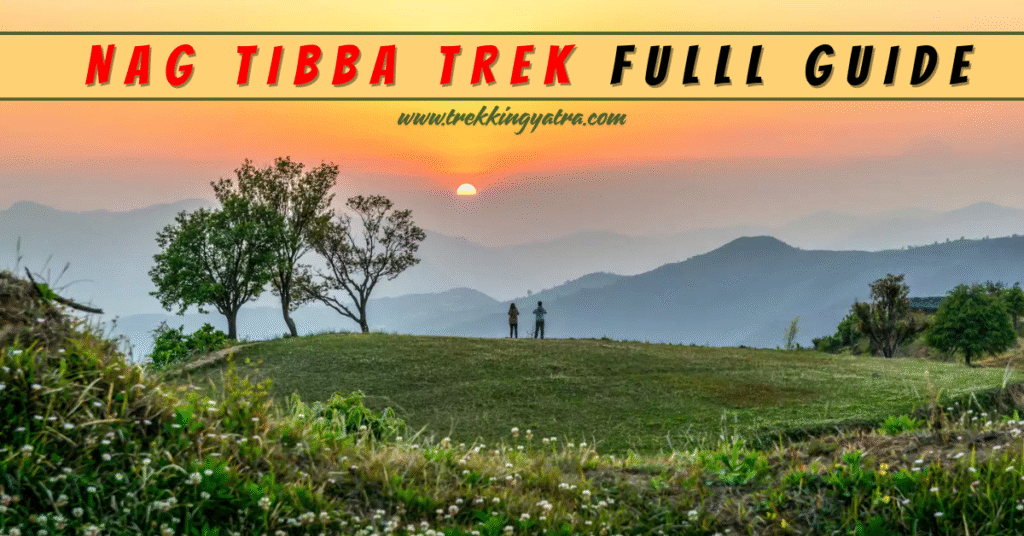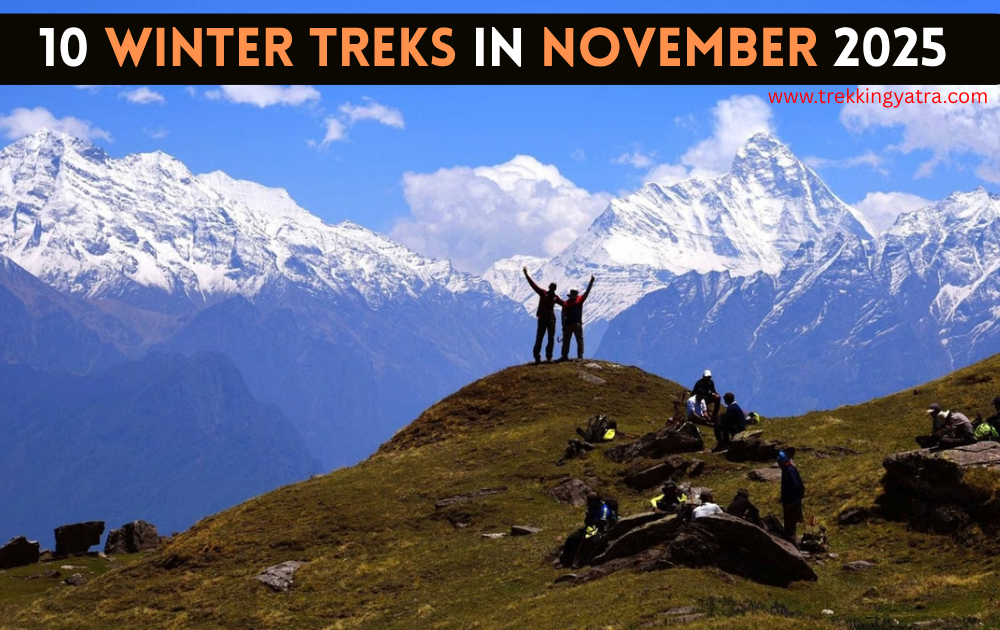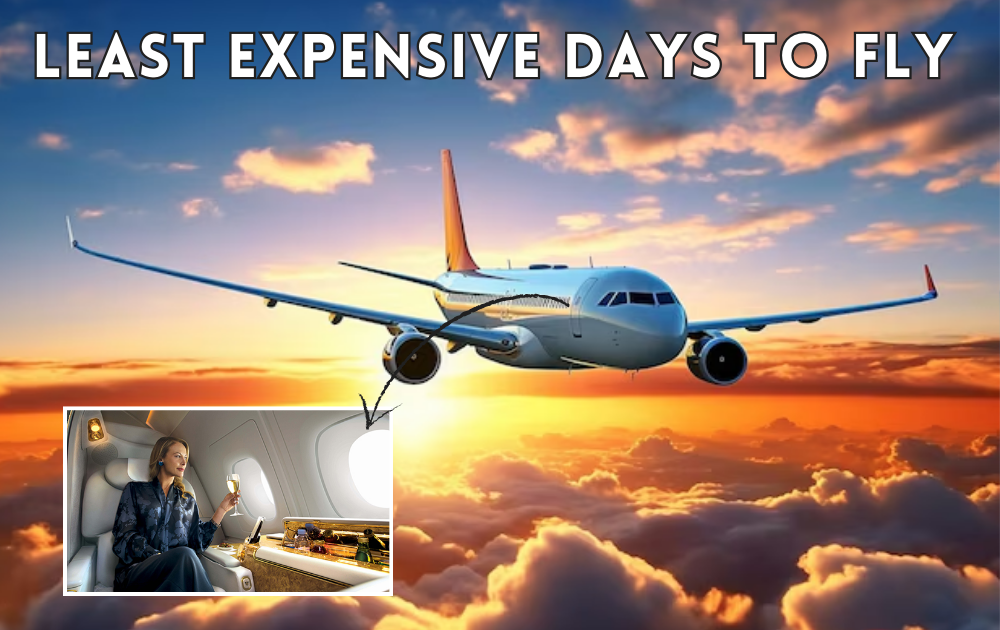Nag Tibba (aka Serpent’s Peak) stands at ~3,022 m (≈9,915 ft) and is the highest peak of the Lesser Himalayas in the Garhwal region. It’s a perfect 2-day weekend trek for beginners and families who want an easy snow-lite Himalayan experience close to Delhi.
Why Nag Tibba Trek in November?
If you want a short, soulful Himalayan escape without long drives or extreme altitudes, Nag Tibba Trek is ideal. November is a sweet spot — post-monsoon clarity with the first dustings of snow at higher elevations, cool days, crisp mornings, and spectacular sunrise views over the Greater Himalaya. The trail mixes oak/pine forests, open bugyals (meadows), and a rewarding summit that gives views of peaks like Bandarpoonch, Swargarohini, and parts of the Gangotri range.
At a glance
- Altitude: ~3,022 m / 9,915 ft.
- Typical duration: 2 days (can be stretched to 3).
- Trek distance: ~12–18 km round trip, depending on route.
- Difficulty: Easy–Moderate (suitable for beginners with average fitness).
- Base / nearest pickup: Pantwari or Dehradun / Mussoorie region (~90–140 km from Dehradun/Mussoorie).
- Best time: October–March for clear skies and snow; April–June for greenery. November is excellent for clear visibility and cooler temperatures
Who should do Nag Tibba?
- First-time trekkers looking for a Himalayan summit in a weekend.
- Families and small groups wanting a short camp + summit experience.
- Photographers seeking wide panoramas at sunrise/sunset without high-altitude logistics.
- City folk (Delhi/NCR) who want a quick winter escape.
Why it’s perfect as a weekend winter trek
- Short drive + short trek: Drive to Pantwari (or similar base) in 3–4 hours from Dehradun, then a day’s moderate trek to camp and a short summit push the next morning.
- Beginner-friendly: Gradual ascents, clear trails, and camping options make it doable for newcomers.
- Snow possibility in Nov–Dec: You can get the “snow feel” without the demands of true high-altitude winter treks.
- Great views: Clear autumn skies give excellent visibility of major Himalayan silhouettes.
Suggested 2-day itinerary (most popular / weekend layout)
Day 0 (Night before / Travel)
- Travel from Delhi to Dehradun (overnight train/bus) or drive to Dehradun. Meet at the pickup point (Dehradun bus stand) early morning
Day 1 — Drive to Pantwari → Trek to Campsite (Nag Mandir / Bugyal)
- Drive: Dehradun → Pantwari / Duktu (approx 3–4 hours).
- Trek: Pantwari → Nag Mandir / Campsite (5–6 hours). Moderate ascent through forests and open meadows. Camp overnight, enjoy sunset and starry skies.
Day 2 — Summit & Return
- Early morning summit push (2–3 hours to Nag Tibba summit), enjoy 360° views and breakfast at the top. Descend back to Pantwari and drive to Dehradun/Delhi (reach by evening).
Optional: Stretch to 3 days to explore nearby trails, rest more, or avoid rush.
Route options & basecamps
- Most common: Pantwari → Nag Tibba (via the Nag Mandir campsite).
- Alternate: Starting from Pantwari via Anchor or Duktu, depending on local conditions and operator. Route lengths vary 12–20 km total. Always check with your operator for the exact route on the day.
How to reach Nag Tibba
- From Delhi: Drive ~6–7 hours (depends on traffic) to Pantwari or Dehradun, or take an overnight train/bus to Dehradun and a morning road transfer.
- Nearest major hub: Dehradun (Jolly Grant Airport / Dehradun Railway Station). From Dehradun, groups usually take a drive to the trailhead.
Permits, guides & booking
- No special permits like for many high-altitude treks, but local regulations can change — always verify with your trek operator.
- Hiring a local guide and porter is recommended (safety, navigation, and local economy). Many operators provide meals, tents, and guides for modest fees. Typical packaged costs: ₹1,500–₹4,000 depending on services.
Weather & what to expect in November
- Daytime: Cool and pleasant (5°C–15°C depending on elevation and sun).
- Night: Freezing to near-freezing at camps (0°C to -5°C possible).
- Trail: Dry and firm early November; by late November, you may see snow patches near the summit. Carry warm layers and waterproof outerwear.
Essential packing checklist (winter/weekend focused)
Clothing
- Thermal base layers (top and bottom)
- Fleece mid-layer + down jacket
- Windproof/waterproof shell (jacket + pants)
- Trekking pants, quick-dry shirts
- Warm socks (2–3 pairs) and liner socks
Footwear & accessories
- Sturdy trekking shoes (waterproof recommended)
- Gaiters (if there’s snow)
- Lightweight crampons/microspikes (if expecting icy patches)
- Sunglasses (UV) + sunscreen + lip balm
Camping & personal
- Warm sleeping bag (rated to -10°C preferred)
- Headlamp + extra batteries
- Reusable water bottle / insulated thermos
- Personal first-aid kit, blister pads
- Snacks: energy bars, dry fruits, glucose
Documents & money
- ID, emergency contacts, small cash (local shops may not accept cards)
Training & fitness
Nag Tibba is beginner-friendly, but a little preparation goes a long way. Practice:
- 3–4 cardio sessions/week (jogging, cycling) for 4 weeks before the trek.
- Stair climbing/incline walks with a daypack.
- Leg strength exercises: squats, lunges, calf raises.
Arrive able to hike 4–5 hours comfortably with a 6–8 kg pack.
Safety tips & responsible trekking
- Acclimatization: While Nag Tibba is not high enough for severe altitude sickness, monitor for headaches, dizziness, or nausea. Descend if symptoms worsen.
- Hydration: Cold weather can mask dehydration—drink regularly.
- Local conditions: Trails change seasonally. After heavy snowfall or rain, local porters/guides are the best source of trail condition updates.
- Leave no trace: Pack out your trash, avoid single-use plastics, respect local sacred sites like the Nag Devta temple at the summit.
Photography & sunrise tips
- Summit early for golden hour — the views of the Greater Himalaya are best with morning light.
- Carry a small tripod and ND/UV filters if you want crisp panoramas.
- Use protective covers for cameras in cold/dusty conditions.
Sample budget (per person, approximate)
- Budget group (basic tent + shared services): ₹1,500–₹2,500
- Standard group (meals, tent, guide): ₹2,500–₹4,000
- Private/solo arrangements: higher depending on transport and private guide.
Prices change by season and services—book through a trusted operator and confirm inclusions.
Quick FAQ
Q: Can I do Nag Tibba in November without prior experience?
A: Yes — it’s one of the most beginner-friendly Himalayan treks. A reasonable fitness base and proper gear are enough.
Q: Will I definitely find snow in November?
A: Not guaranteed — early November might have snow patches at the summit; late November to December increases snow likelihood. Check local updates before traveling.
Q: Is camping necessary?
A: Most weekend itineraries include one night of camping. You can also find homestay-style arrangements depending on the route and operator
Q: How crowded is the trail?
A: Popular on weekends and peak seasons; weekdays are quieter. If you prefer solitude, avoid public holiday weekends.
Final notes — Making the most of your weekend
Nag Tibba is perfect for a fast Himalayan fix: minimal logistics, maximum payoff. For November 4 — aim for crisp skies, sunrise views, and the soft hush of early winter on the bugyals. Book a trusted operator, pack warm, and enjoy a short but memorable Himalayan weekend.



